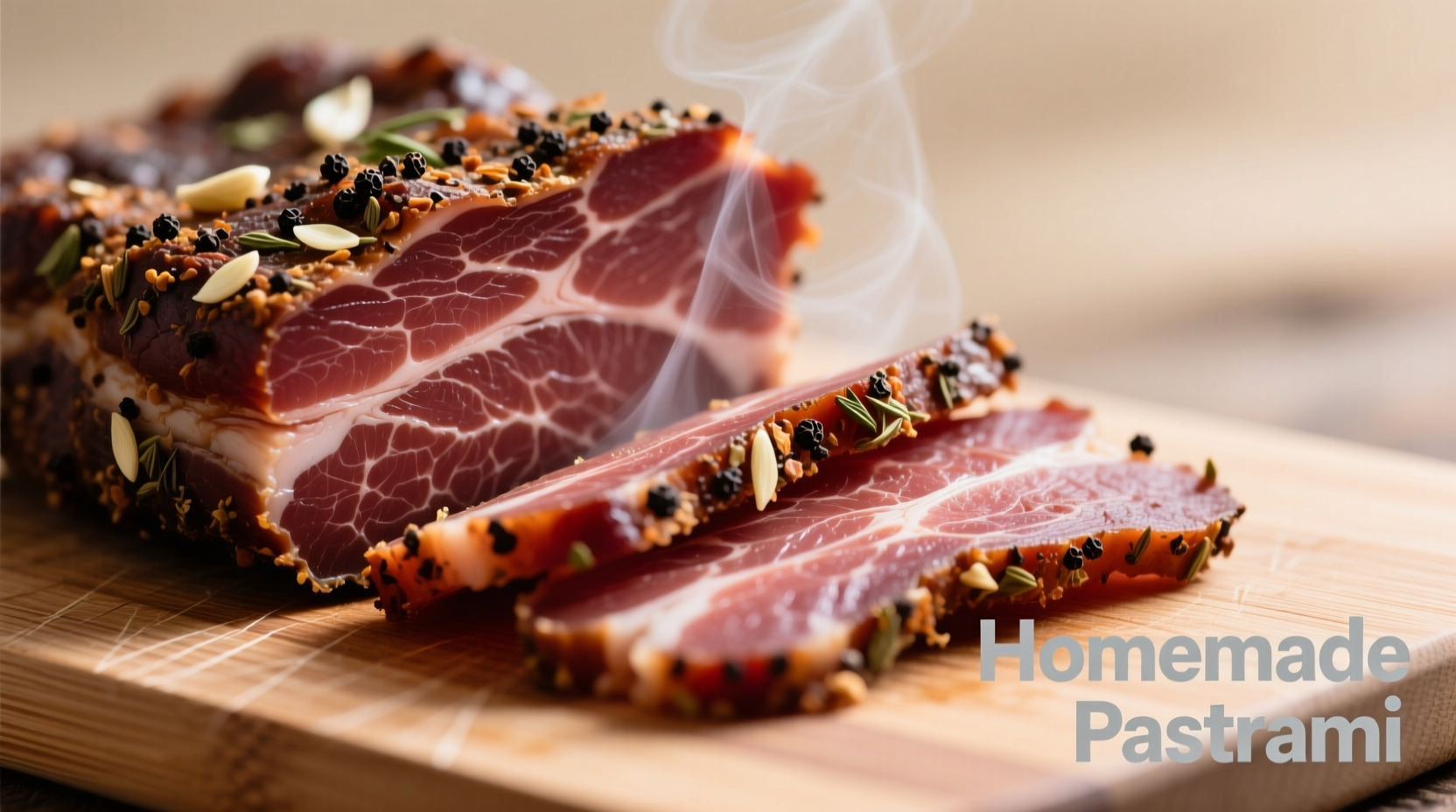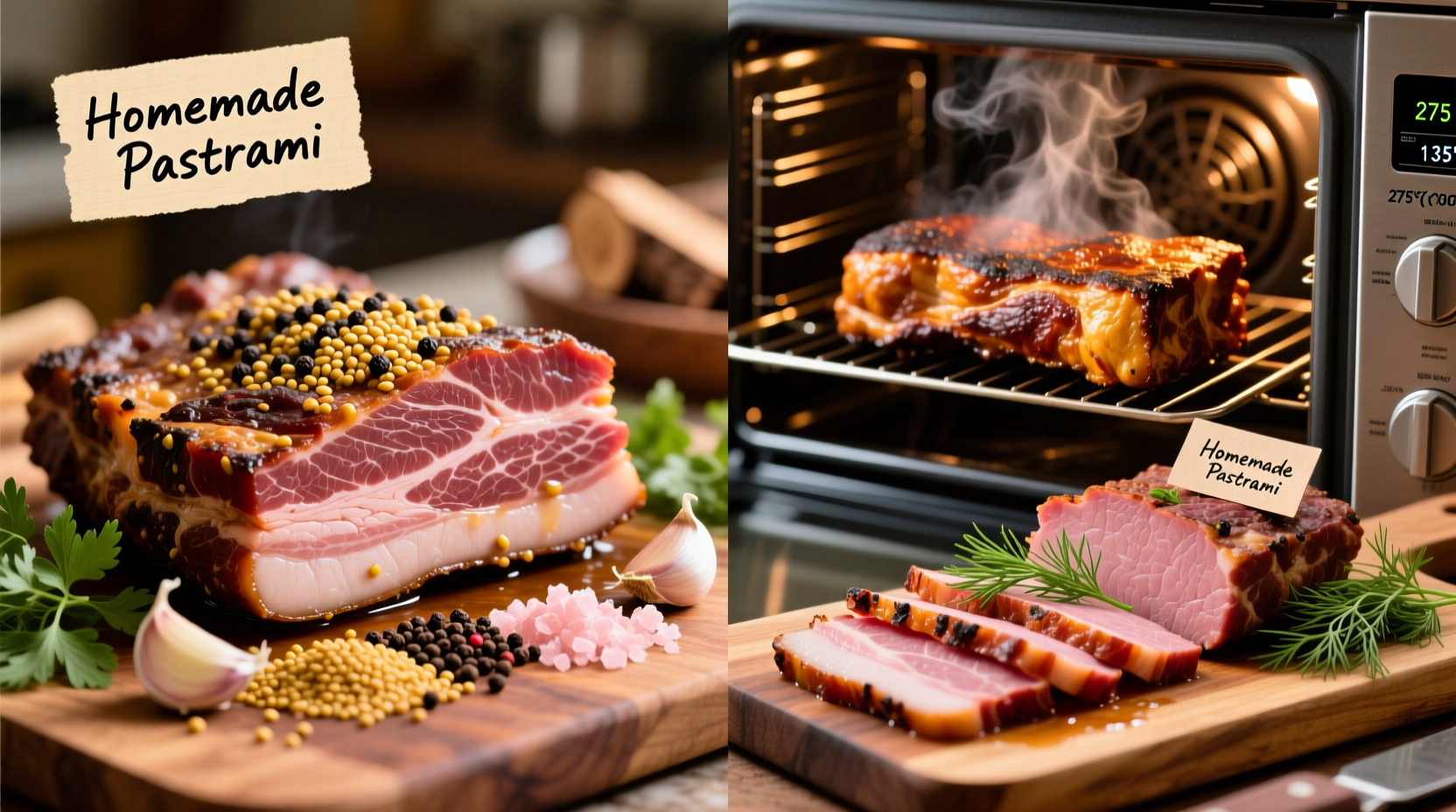Here's the direct answer: To cook authentic pastrami, you need to cure beef brisket for 5-7 days with a spice rub containing coriander, black pepper, garlic, and mustard seeds, then smoke it at 225°F for 4-6 hours until it reaches 165°F internally, followed by steaming for 2-3 hours until fork-tender. The complete process takes 7-10 days but yields melt-in-your-mouth results that surpass store-bought versions.
Want to transform ordinary brisket into restaurant-quality pastrami that impresses even seasoned deli lovers? You've come to the right place. After teaching thousands of home cooks the art of authentic pastrami, I've refined a method that balances tradition with modern kitchen practicality. Forget those rubbery deli slices—this guide delivers the juicy, flavorful pastrami you've been craving, with clear instructions for every step of the process.
Your Pastrami Success Roadmap
Before we dive into details, here's what you'll master by the end of this guide:
- How to select the perfect cut of meat (hint: it's not what most recipes tell you)
- The exact curing ratio that prevents oversalty or bland results
- Smoking temperatures that avoid dry, tough pastrami
- Slicing techniques that make all the difference in texture
- Common mistakes 95% of home cooks make (and how to avoid them)
Why This Method Beats Store-Bought Pastrami
Commercial pastrami often uses shortcuts like liquid smoke and steam tables that sacrifice flavor and texture. When you make pastrami at home following traditional methods, you control every element—from the quality of meat to the precise spice balance. The USDA Food Safety and Inspection Service confirms that proper home curing at controlled temperatures (below 40°F) is safe when following recommended curing ratios, debunking common safety concerns about home-cured meats (USDA FSIS, 2023).
The Complete Pastrami Timeline: What to Expect
| Stage | Duration | Critical Success Factors |
|---|---|---|
| Meat selection & trimming | 30-60 minutes | Choose well-marbled brisket point cut with 1/4" fat cap |
| Curing process | 5-7 days | Maintain consistent refrigerator temperature (34-38°F) |
| Rinse & dry | 12-24 hours | Pat completely dry for optimal smoke adhesion |
| Smoking phase | 4-6 hours | Hold steady 225°F until internal temp reaches 165°F |
| Steaming phase | 2-3 hours | Steam until internal temp hits 200-205°F for perfect tenderness |
| Resting & slicing | 1-2 hours | Slice against the grain at 1/8" thickness |
Selecting Your Foundation: The Right Cut of Meat
While many recipes suggest using the entire brisket, professional delis almost exclusively use the brisket point cut (also called the deckle). This well-marbled section contains more fat and connective tissue, which breaks down during the long cooking process to create that signature juicy texture. The flat cut often becomes dry during the extended steaming phase.
Pro tip: Look for USDA Choice or Prime grade brisket with visible marbling throughout. Avoid "enhanced" or "solution-injected" meats, as the added sodium solution will throw off your curing ratio. A 4-5 pound point cut yields about 3 pounds of finished pastrami after cooking.
The Curing Process: Where Flavor Begins
Curing isn't just about preservation—it's where pastrami develops its distinctive flavor profile. The traditional dry cure method works best for home cooks:
- Mix 1 cup kosher salt, 1/2 cup brown sugar, 2 tablespoons pink curing salt (Prague Powder #1), 3 tablespoons crushed coriander seeds, 2 tablespoons black peppercorns, 1 tablespoon garlic powder, and 1 tablespoon mustard seeds
- Rub mixture thoroughly over all surfaces of the brisket
- Place in a zip-top bag or non-reactive container
- Refrigerate for 5-7 days, flipping daily
The pink curing salt (sodium nitrite) is essential for preventing botulism during the curing process and creating pastrami's characteristic pink color. The USDA recommends using no more than 1 teaspoon of Prague Powder #1 per 5 pounds of meat for safety (National Center for Home Food Preservation).
Smoking for Flavor Development
After curing, rinse the brisket thoroughly and pat completely dry. Let it air-dry uncovered in the refrigerator for 12-24 hours to form a pellicle—a tacky surface that helps smoke adhere.
Smoke at 225°F using cherry or hickory wood until the internal temperature reaches 165°F (about 4-6 hours). This "smoke ring" phase develops the distinctive flavor without overcooking the meat. Maintain consistent temperature—fluctuations cause uneven cooking and texture issues.
The Steaming Secret: Achieving Perfect Tenderness
Unlike commercial producers who often skip this step, traditional pastrami requires steaming after smoking. This crucial phase breaks down collagen without drying out the meat:
- Place smoked brisket in a steam pan with 1" of water
- Cover tightly with foil
- Steam at 225°F until internal temperature reaches 200-205°F (2-3 hours)
- Check tenderness with a fork—it should slide in with no resistance
This two-stage cooking method (smoke then steam) creates the perfect balance of flavorful exterior and tender interior that defines great pastrami.
Slicing Like a Pro: The Final Critical Step
Even perfectly cooked pastrami can be ruined by improper slicing. Follow these guidelines:
- Rest the cooked pastrami for at least 1 hour before slicing
- Use a sharp carving knife or electric slicer
- Slice against the grain at 1/8" thickness
- Keep slices uniform for consistent texture
Slicing against the grain shortens the muscle fibers, making each bite more tender. Thinner slices (about the thickness of a nickel) showcase the marbling and ensure the perfect melt-in-your-mouth experience.

Traditional vs. Modern Pastrami Methods: What Works Best
| Element | Traditional Method | Modern Shortcut | Recommended Approach |
|---|---|---|---|
| Curing time | 7-10 days | 24-48 hours | 5-7 days for optimal flavor development |
| Curing method | Dry cure only | Wet brine | Dry cure for better spice penetration |
| Smoking wood | Cherry or hickory | Liquid smoke | Real wood smoke for authentic flavor |
| Final cooking | Steaming | Oven roasting | Steaming for proper tenderness |
| Slicing thickness | 1/8" | 1/4" | 1/8" for ideal texture and presentation |
Storage and Serving Tips
Properly stored, homemade pastrami lasts:
- Refrigerated: 7-10 days in airtight container
- Frozen: 2-3 months (slice before freezing for best results)
- Reheating: Steam slices for 2-3 minutes or warm in broth
Serve on rye bread with mustard for the classic experience, or try it in pastrami eggs Benedict, pastrami grilled cheese, or as a pizza topping. The intense flavor works well in small portions—2-3 ounces per serving is typically sufficient.
Troubleshooting Common Pastrami Problems
Problem: Pastrami turned out dry
Solution: You likely skipped the steaming phase or used the flat cut instead of the point. The steaming phase is non-negotiable for proper tenderness.
Problem: Overly salty pastrami
Solution: The cure ratio was off or you didn't rinse thoroughly. Always measure curing ingredients by weight for accuracy.
Problem: Weak smoke flavor
Solution: The pellicle didn't form properly. Ensure proper air-drying time in the refrigerator before smoking.
Final Pro Tips for Pastrami Perfection
Based on years of perfecting this recipe, here are my top recommendations:
- Toast whole spices before grinding for maximum flavor release
- Use a digital thermometer at every stage—guessing leads to inconsistent results
- Don't rush the curing process—flavor develops over time
- Save the fat trimmings to render for cooking potatoes or eggs
- Make extra—it freezes beautifully and makes fantastic gifts











 浙公网安备
33010002000092号
浙公网安备
33010002000092号 浙B2-20120091-4
浙B2-20120091-4